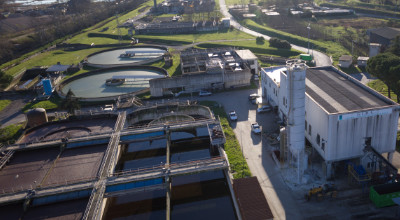Bilanci 2025
The current year's financial statement is not yet available. For the financial statements of previous years, please refer to the "Archive" section.
The current year's financial statement is not yet available. For the financial statements of previous years, please refer to the "Archive" section.
The document published is the one in force as of November 12, 2024.
There are no appeals filed by holders of legally relevant and homogeneous interests as of May 27, 2024.
It applies exclusively to entities, companies, and private structures that provide services on behalf of the National Health Service (SSN).
It does not apply as G.I.D.A is not a company fully owned by public entities or with predominant public capital, included in the consolidated financial statement of the public administration as identified by ISTAT.
In the system, it is possible to quickly and easily report actual or suspected conduct that may have a negative impact on the integrity of the company and/or individuals in the workplace.
Access it via the link below:
Subject to whom the request should be submitted:
President Of the Board of Directors: Brogi Alessandro : [email protected] TEL. +39 -0574-646511.
Holder of substitute authority in case of delay or lack of response:
Coordinator of Administration, Finance, and Control: Stefani Marzia : [email protected] TEL. +39 -0574-646511
The above indications apply both to simple civic access and to generalized civic access.

With a process that began in 1997, the depuration plants of the municipalities of Vaiano, Vernio and Cantagallo also became part of the system: they're all characterized by being located along the Bisenzio river and by treating discharges mainly originating from the textile industry. Also for these plants, the Company has provided, where necessary, structural adjustments.
The sewage depuration plant of Vaiano (30,000 P.E.), treats an average of 8,000 cubic meters/day on weekdays, reducing about 4,000 kg/day of COD and little less than 150 kg/day of surfactants. It basically consists of equalization, denitrification, biological oxidation, secondary sedimentation and final ozonation.
The sludge line consists of gravity thickening, aerobic digestion and mechanical dewatering with centrifuge. The sludge resulting from the purification process amounts to about 2,000 t/year at 18% of D.M.
The sewage treatment plant of Vernio (30,000 P.E.), on weekdays, treats an average of 7,000 cubic meters/day, reducing about 4,000 kg/day of COD and little less than 100 kg/day of surfactants. It basically consists of equalization, biological oxidation and secondary sedimentation. It is also planned to install a final filtration section for the reduction of suspended solids. The sludge line consists of gravity thickening, aerobic digestion and mechanical dewatering with belt press. The sludge resulting from the purification process amounts to about 1,500 t/year at 20% of D.M.
The sewage treatment plant of Cantagallo (35,000 P.E.), on weekdays, treats an average of 10,000 cubic meters/day, reducing about 4,000 kg/day of COD and just under 100 kg/day of surfactants. Basically, it consists of equalization, denitrification, biological oxidation, secondary sedimentation. The peculiarity of this plant is to be completely covered. It is also planned to install a final section followed by ozonation for the reduction of color. The sludge line consists of gravity thickening, aerobic digestion and mechanical dewatering with centrifuge. The sludge resulting from the purification process amounts to about 1,500 t/y at 20% of D.M.

The second largest depuration plant in Prato is Calice which was started in 1985 and is located in the western part of the municipality, on the border with the Municipality of Agliana. The plant was structurally adapted in 2000 and almost doubled in 2002.
The sewage drained in the west of the city and those coming from the nearby Municipality of Montemurlo converge treatment plant of Prato-Calice (190,000 P.E.).
The Calice depuration plant, on weekdays can treat up to 39,000 cubic meters/day and can break down up to 20,000 kg/day of COD and 1100 kg/day of surfactants. Basically it consists of equalization, primary sedimentation, denitrification, biological oxidation, secondary sedimentation, clear final flocculation, sand filters and ozonation. The sludge line consists of gravity thickening, mechanical dewatering with centrifuge and filter press. The resulting sludge from the purification process can amount up to 10,000 t/year with a variable humidity between 64 and 74%.

The centerpiece of the centralized depuration system is Baciacavallo purification plant, located in the south-east of the city, near the border with the Municipality of Poggio a Caiano. The previously existing millponds Mazzoni, Bresci and Romita together with the pressurised collectors that drain the two new industrial areas (macrolotti) converge on it. The first core of the plant dates back to 1980.
In 1986 the treatment line was almost doubled.
In 1992 the ozonation plant was built for the removal of surfactants and color. In 1999 the tertiary treatment of clariflocculation was doubled and at the same time the dewatering section of the residual sludge was strengthened and modernized.
On weekdays, the plant can treat up to 130,000 cubic meters/day, reducing up to 100,000 kg/day of COD and 4,500 kg/day of surfactants. Basically it consists of equalization, primary sedimentation, biological oxidation, secondary sedimentation, clariflocculation and final refinement with ozone, for the reduction of color and residual surfactants. The sludge line consists of gravity thickening, mechanical dewatering with centrifuges and sludge incineration.
The latter section includes a 100 t/day multistorey incinerator, equipped with post-combustion, gas treatment train, filter bags and continuous emission analyser. The production of sludge resulting from the purification process can reach 30,000 t/year at 75% humidity.